More closed, classical sound.
Hello everyone. I'm about to start doing Ken's program vol. 1 but I have some doubts on whether the way it is tought here will lead me to a sound I want to achive. Sorry if i'm wrong with some terms, I'm just a beginner, correct me please. I've noticed in the vids where Ken shows how to sing like some artists like John Legend, Sam Smith and espacially Matt Bellamy, he doesn't have nearly the same sound they do, which is more of a closed, classical, more head resonance sound I guess. I understand that he is more of a rock guy, and I have nothing to say, he is awesome. But I just want to know if this program is suitable for me. So, he sings perfectly same notes but sounds thinner, really chesty and bright, and thats not the sound I'd like to have in the end. With Matt Bellamy for example, this guy sounds, pardon me) more like an SLS school student, but with bigger voice. So what I'm thinking strething your chest is more benefitial for youre range, but will my voice using this course have a sound most artist I like have? Thank you.


Comments
This course emphasizes a more open, bright sound. You have to work at it to get that bright sound, or else you will tend to have more of a closed, rounded sound. If that's what you want, then you can just cover your teeth more with your lips, and other things that differentiate between covered, more operatic sound, and the bright ping that Ken emphasizes.
The reason for the bright sound is that it is a more modern sound, as opposed to classical, and the bright sound emphasizes natural resonance more. A darker, more closed sound tends more towards a hooty resonance. A brighter sound tends towards more brilliance in the sound when resonating.
Just like those who only want a softer, more R and B or classical sound can learn to bridge early and skip chest voice stretching, you could elect to stay with the darker sound if that is your preference. Otherwise, the vocal principles taught still apply. KTVA is a modernized derivative of Bel Canto singing. It has been made more efficient for the modern singer.
If you elect to go for the darker sound, and skip chest-stretching, you won't be able to sing in those extended-range styles. It's easy to bridge lower after learning to bridge higher. It's impossible to bridge higher if you have only trained bridging lower. Likewise, it's easy to sing darker after having learned to sing brightly, but learning to sing bright is a lot more work if you have trained singing covered and dark.
Ken recommends learning to stretch chest voice with the bright voice, because it offers more options.
All the Best!
Bob
Training all aspects gives you options. Training in only the easier areas fences you in.
KTVA trains you to extend your chest voice up, then trains you to take a timbral head voice that matches up with your chest voice, down into your chest voice range. You can also do a less timbral, "head dominant", hootier sound if you like. It's easy. When you have a huge overlap between your upper chest and lower head ranges, you can then blend whatever amounts of whatever timbres you would like to use, because you have trained your voice in all of these areas instead of just the standard "chest" and "head" voices that most vocal methods are limited to.
All the Best.
Bob